(单词翻译:单击)
Rail service in rural Sichuan is a life line for local people and a big pull for tourists who want a last glimpse of the age of steam
四川农村地区的铁路线是当地人民的生命线,想目睹蒸汽机车最后一眼的人们也可以在这里看到。
It isn't the quickest of commuter trains,taking 75 minutes to cover just 12 miles. Nor is it the quietest: speech is barely audible over the rattles and blasts of steam. It is certainly not the most comfortable. Passengers jolt along in unlit cars and on windy days their clothes are specked with ash.
这并非最快速的通勤火车,12英里的路程要花费75分钟。也并非是最安静的火车:在巨大轨道声音和蒸汽声的掩盖下,几乎听不见人们讲话。这也并非是最舒适的火车。乘客们在昏暗的车厢里颠簸前行,在有风的日子里,人们的衣服上会沾满灰烬。
But the journey from Shixi to Huangcunjing may well be the most memorable ride they will ever experience. The narrow-gauge railway, running through a lush valley in Sichuan, is one of the last regular passenger steam train services in the world.
但是这段从石溪到黄村井的旅程可能会给人们留下最难忘的记忆。这条经过四川省茂盛山谷的窄轨铁路是世界上仅存的最后几条客运蒸汽机车之一。
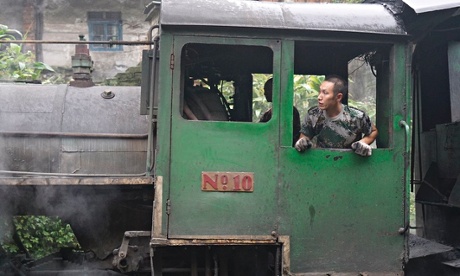
"Steam locomotives are about the nearest thing man has ever created to a living creature," said David Longman, who has photographed working steam locomotives all over the world
“蒸汽机车是人类所创造的最令人感到亲近的事物,”David Longman如是说,他拍摄了世界上还在运行中的蒸汽机车。
Now their numbers are in such swift decline that updating his website "is like running an obituaries page", he said. "It's been a steady decline since the turn of the century. Virtually everything has gone."
而蒸汽机车的数量正在急剧减少,所以他在更新自己的网站his website时就好像在发布讣告,他说:“世纪之交以来,蒸汽机车的数量就开始渐渐减少,几乎都消失了。”
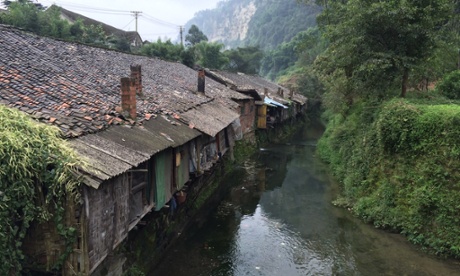
China is one of the few countries where they still run for practical–mostly industrial–purposes rather than as tourist attractions, but even here the services are fast disappearing.
中国是少数几个依然将蒸汽机车作为实际用途(大多数是工业用途)而不是将其作为旅游景点的国家之一,但是即使是在中国,蒸汽机车所提供的服务也正在快速消失。
Shixi lies three hours' drive from Chengdu,the provincial capital of Sichuan. In recent years, tourist carriages have beenadded to the regular trains and extra sightseeing services scheduled. But forresidents, this is still their lifeline.
石溪离成都有三小时的车程,成都是四川的省会城市。最近几年,在普通的蒸汽机车上添加了旅客车厢,也开办起了观光旅游服务。但是对当地居民来说,这依然是他们的生命线。
Until a couple of years ago, there was noroad to the last stops on the line. The area's new concrete road still does not reach most of the stations and is too narrow for much traffic so even now,people walk or ride motorbikes straight down the railway line.
直到几年前,这条铁路线的最后几站还没有通公路。新建的混泥土公路也没能延伸到大多数的站点,而且车一多道路就显得狭窄,所以即使到了现在,人们都会直接在铁轨上走路或者骑摩托车。
For those who pay the five yuan (50p) fare,on busy days the few seats soon run out and passengers must cling to a rail suspended from the ceiling as the train bumps over the track. Women lugvege tables in woven baskets on their backs as they clamber on. There is noglass in the windows: when it rains, you get wet or pull up the metal shutters and sit in darkness.
对于那些支付5元钱坐火车的人来说,在忙碌的日子里,里面少数几个座位早就被人占去了,所以在颠簸的火车里只能扶着天花板上的扶手前进。妇女门背上背着编织筐上了火车,筐里面满满的是自己种的蔬菜。火车上的窗户根本没有玻璃:每当下雨时,要不就是被淋湿,要不就是拉上金属百叶窗并坐在黑暗里。
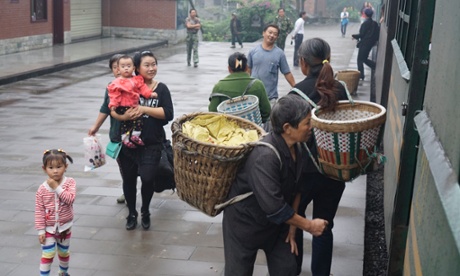
But on fine days you admire the bamboo groves, rice terraces and fields of flowers. Residents rush out as the train passes, armed with tongs to pick up dropped embers for their stoves.
但如果是晴天,你就可以欣赏到外面美丽的竹林,梯田以及花海。火车经过时当地居民四处散开,用火钳拾起火车上抛下的余火未尽的煤块用以自己烧火。
A brief flirtation with diesel engines inthe early 1990s was soon abandoned, probably because it was not cost-efficient.So the service continues at its old pace, so slow that, were Mo Farah to raceit, he could celebrate his victory with a leisurely cup of tea before it had caught up.
90年代初期时使用过柴油发动机,但很快就被抛弃,可能是因为不合算。所以速度依然是那么慢,甚至是英国长跑选手法拿都能跑赢它。
China now boasts 6,800 miles of high-speed track, with trains running 18 times faster than those on the Shixi line. But this railway too seemed like a step into the future when it was completed in 1959. It was built as part of the Great Leap Forward, Mao'sinsanely ambitious modernisation drive in industry and agriculture, which led to a devastating famine that killed tens of millions.
中国现在拥有6800英里的高铁,其速度是这条铁路的18倍。但是这条铁路在1959年建成时,当时的人们也觉得这条铁路就是未来。这条铁路是作为大跃进的一部分建成的。大跃进是毛为了对工业和农业进行现代化而采取的疯狂举动,导致大饥荒,数千万人因此死亡。
Thousands of workers toiled on this shortstretch of track. "We didn't have equipment. It was all manpower: there were people everywhere," said a man in his 70s who worked on the project as ateenager. "We started work before dawn and by the time we finished it would be dark."
数千工人辛苦工作才完成了这个铁路建设。“我们当时没有设备。都是靠人力:到处都是人,”一名70岁的老者说道,在他还是青少年时就参加了这个铁路建设。“在黎明前我们就开始工作了,工作结束时天都已经黑了。”
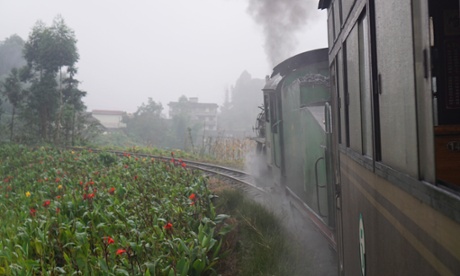
The train was used to carry freight from the mine at Huangcunjing, which opened in the 1930s as a Sino-British joint venture. Previously, workers had pushed the coal to a nearby river by wheel barrow. Soon after it opened, carriages were added for the miners and their families who lived a short walk away, at Bagou. Since then, the train has carried an estimated 11.6 million people and 18m tonnes of coal.
这个火车原先是用来运输黄村井的矿产资源的,该矿是在1930年代的时候由中英合资开采的。而在火车建成前,工人们要通过独轮车将煤炭运到附近的河流里。火车开通后,在原先的基础上添加了车厢,这样居住在附近的矿工及其家人就可以方便往返了。
Liang Shufang, 82, moved to Bagou when she married a miner in 1950. Others soon followed her, as workers gained more status under Communist rule. "At the beginning, girls didn't respect miners and didn't want to marry them. Then miners got better lives and better pay … Beinga worker was a very powerful thing," she said.
今年82岁的梁淑芳1950年与一名矿工结婚后搬到了巴沟。其他妇女随后也追随了她的脚步,因为在共产主义统治下,工人们的地位得到了提升。“起先,女孩子们并不看好矿工,都不愿意嫁给他们。之后,矿工的生活更好了,工资也更高了。。。当时,成为一名工人是很厉害的事情,”她说。
The arrival of the railway completed Bagou's transformation into a booming industrial town, with more than 7,000 residents. Miners held mass sports events in the main square and performances on its grand stage. Later, during the Cultural Revolution, the platform hosted vicious struggle sessions as factions battled.
铁路的建成使得巴沟完全成为了一个繁荣的工业小镇,7000多居民。矿工们在中央广场上以及舞台里举行大量的体育赛事和表演。后来,在文革期间,随着派系斗争的开始,这些平台上上演的是一次次恶毒的批斗大会。
Chairman Mao's portrait still hangs over the square and slogans from the era adorn the walls of nearby buildings. This is the town that time forgot.
毛主席的画像依旧悬挂在广场上,那时期的口号依然出现在附近建筑的墙壁上。这是一座被时间遗忘的小镇。
The pit closed in 1988, when the coal seam was exhausted. The schools, the hospital and the grand workers'theatre soon followed. Plants poke through the tiled roofs of abandoned homes. Butterflies the size of a hand flutter past, flashing emerald.
矿井于1988年关闭,因为煤层都被采尽了。随后,学校,医院和工人大舞台也都相继关闭了。被抛弃的房屋屋顶被植物所刺穿。手掌大的蝴蝶振翼飞过。
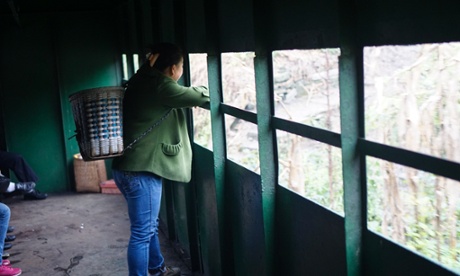
Perhaps 1,000 residents remain, living offtheir savings, government benefits and the food they grow: plantains, rice, soybeans and pomelos. "After they built the railway, these streets were full of people," recalled Zhao Bingrun, 65, as he stood at the door of his store,beneath fading characters reading: "Chairman Mao is the reddest sun in the heart of revolutionary people everywhere in the world."
大约有1000名居民留了下来,靠存款,政府福利以及自己种的食物过活,这些食物包括:大蕉,水稻,大豆,柚子。“在他们建完铁路后,这里的街道都是人,”65岁的赵炳润站在自己店面的门边上回忆到,门上褪色的文字这样写道:“在全世界的革命者心中,毛主席是最红的太阳。”
His shop is one of the few still open on what used to be the busy main street and he would sell it if he could find abuyer. Further down, a hen scratches in the dirt; a cat lazes on a windowsill."Without the tourists, this place would be completely empty," Zhao said
在曾经热闹的街道上,他的店铺是唯一还在开的几家之一,如果有买家的话,他想把这个店铺卖出去。一只母鸡在你泥土里乱扒;一只猫在窗台上懒散的消磨时光。“如果没有游客,这个地方将空荡荡的,”他说。
Daytrippers arrive on sight seeing trains,which cost 10 times the regular fare and have ensured the standard services can keep running.
不过夜的游客通过观光列车抵达这里,费用是常规费用的10倍,保证了标准的服务能够得到延续。
Most travellers come from Sichuan, but some from Japan, Russia, the UK and even Afghanistan: rail enthusiasts eager to witness the last puffs of the age of steam.
大多数游客来自四川,有些来自日本,俄罗斯,英国,甚至是阿富汗:铁轨爱好者急于一睹蒸汽机车最后的喘息。


